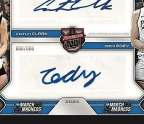
If a time traveler like Marty McFly could use a DeLorean to journey back to November of 1955, he would find himself in the final days of the famous “Card Wars” of the 1950s.
The battle which began in the spring of 1951 was reaching its conclusion. The Bowman Card Company, founded in Philadelphia in 1927 by J. Warren Bowman for the manufacture and sale of chewing gum, was about to surrender to the victorious Topps. The official end came in January of 1956 when Topps paid $200,000 for all of Bowman's assets, most importantly its contractual rights for professional baseball and football cards.
Bowman did not go down without a fight. From 1951-55, it went toe-to-toe with Topps in the baseball card market, even seemingly prevailing in 1955 with its “Television Set” of 320 cards, surpassing Topps' meager 206. The two were even competing in the field of non-sports cards, with both issuing sets of U.S. Presidents, ships and planes, movie and recording stars, and historical figures. These subjects were nothing new to Bowman. The company had been issuing non-sports sets since the early 1930s under its prior name of






